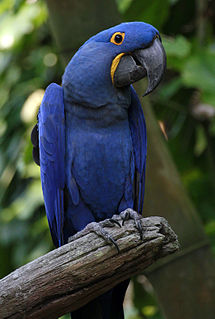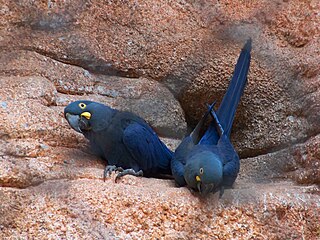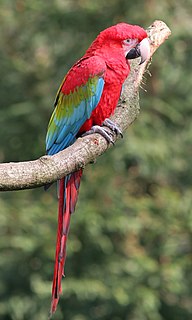 W
WMacaws are long-tailed, often colorful, New World parrots. They are popular in aviculture or as companion parrots, although there are conservation concerns about several species in the wild.
 W
WMini-macaws are a loosely defined group of small-to-medium-sized macaw species within the tribe Arini. The term has no fixed taxonomic meaning and is principally used in aviculture to describe a small macaw belonging to one of a number of different genera, with overall length being the sole criterion for inclusion. Any macaw with an overall length of less than about 50 cm can be described as a "mini-macaw". Additionally, the "mini-" prefix may be added to the species name when describing the bird in question.
 W
WThe blue-and-yellow macaw, also known as the blue-and-gold macaw, is a large South American parrot with mostly blue top parts and light orange underparts, with gradient hues of green on top of its head. It is a member of the large group of neotropical parrots known as macaws. It inhabits forest, woodland and savannah of tropical South America. They are popular in aviculture because of their striking color, ability to talk, ready availability in the marketplace, and close bonding to humans.
 W
WThe blue-headed macaw or Coulon's macaw is native to eastern Peru, north-western Bolivia, and far western Brazil. It has a total length of about 41 cm (16 in), making it a member of the group of smaller macaws sometimes known as the mini-macaws, which includes any species of macaw with a total length of 50 cm (20 in) or less. As in all macaws, its tail is long and pointed and the bill is large and heavy.
 W
WThe blue-throated macaw, also known as the Caninde macaw or Wagler's macaw, is a macaw endemic to a small area of north-central Bolivia, known as Los Llanos de Moxos. In 2014 this species was designated by law as a natural patrimony of Bolivia, where it is known as barba azul, which means 'blue beard' in Spanish. Until 2010, it was hunted by natives to make feathered "Moxeño" headdresses for "machetero" ritual dances.
 W
WThe chestnut-fronted macaw or severe macaw is one of the largest of the mini-macaws. It reaches a size of around 45 cm (18 in) of which around half is the length of the tail.
 W
WThe Cuban macaw or Cuban red macaw was a species of macaw native to the main island of Cuba and the nearby Isla de la Juventud that became extinct in the late 19th century. Its relationship with other macaws in its genus was long uncertain, but it was thought to have been closely related to the scarlet macaw, which has some similarities in appearance. It may also have been closely related, or identical, to the hypothetical Jamaican red macaw. A 2018 DNA study found that it was the sister species of two red and two green species of extant macaws.
 W
WThe glaucous macaw is a large, blue and grey South American parrot, a member of a large group of neotropical parrots known as macaws. This macaw, generally believed to be extinct, is closely related to Lear's macaw A. leari and the hyacinth macaw A. hyacinthinus. In Guaraní, it is called guaa-obi after its vocalizations.
 W
WThe great green macaw, also known as Buffon's macaw or the great military macaw, is a Central and South American parrot found in Nicaragua, Honduras, Costa Rica, Panama, Colombia and Ecuador. Two allopatric subspecies are recognized; the nominate subspecies, Ara ambiguus ssp. ambiguus, occurs from Honduras to Colombia, while Ara ambiguus ssp. guayaquilensis appears to be endemic to remnants of dry forests on the southern Pacific coast of Ecuador. The nominate subspecies lives in the canopy of wet tropical forests and in Costa Rica is usually associated with the almendro tree, Dipteryx oleifera.
 W
WThe hyacinth macaw, or hyacinthine macaw, is a parrot native to central and eastern South America. With a length of about one meter it is longer than any other species of parrot. It is the largest macaw and the largest flying parrot species, though the flightless kakapo of New Zealand can outweigh it at up to 3.5 kg. While generally easily recognized, it could be confused with the smaller Lear's macaw. Habitat loss and the trapping of wild birds for the pet trade have taken a heavy toll on their population in the wild, so the species is classified as Vulnerable on the International Union for Conservation of Nature's Red List, and it is protected by its listing on Appendix I of the Convention on International Trade in Endangered Species of Wild Fauna and Flora (CITES).
 W
WHybrid macaws are the product of cross breeding of more than one species of macaw, resulting in a hybrid. They are often characterized and bred for their unique and distinct coloring, and for this reason, are highly sought after and valued in the exotic pet trade. Macaws are native to tropical North and South America. Hybridization of macaws occurs both in nature and captivity, being one of the few species that can produce viable, fertile offspring unlike many other hybrids produced from crossing different species resulting in sterile hybrids with factors that limit their success of survival. Hybrid macaws do not hold any scientific names, and are often labeled by the two macaw species they are produced from
 W
WLear's macaw, also known as the indigo macaw, is a large all-blue Brazilian parrot, a member of a large group of neotropical parrots known as macaws. It was first described by Charles Lucien Bonaparte in 1856. Lear's macaw is 70–75 cm (28–30 in) long and weighs around 950 g (2.09 lb). It is metallic blue with a faint, often barely visible, tinge of green, and a yellow patch of skin at the base of the heavy, black bill.
 W
WThe Lesser Antillean macaw or Guadeloupe macaw is a hypothetical extinct species of macaw that is thought to have been endemic to the Lesser Antillean island region of Guadeloupe. In spite of the absence of conserved specimens, many details about the Lesser Antillean macaw are known from several contemporary accounts, and the bird is the subject of some illustrations. Austin Hobart Clark described the species on the basis of these accounts in 1905. Due to the lack of physical remains, and the possibility that sightings were of macaws from the South American mainland, doubts have been raised about the existence of this species. A phalanx bone from the island of Marie-Galante confirmed the existence of a similar-sized macaw inhabiting the region prior to the arrival of humans and was correlated with the Lesser Antillean macaw in 2015. Later that year, historical sources distinguishing between the red macaws of Guadeloupe and the scarlet macaw of the mainland were identified, further supporting its validity.
 W
WThe Martinique macaw or orange-bellied macaw is a hypothetical extinct species of macaw which may have been endemic to the Lesser Antillean island of Martinique, in the eastern Caribbean Sea. It was scientifically named by Walter Rothschild in 1905, based on a 1630s description of "blue and orange-yellow" macaws by Jacques Bouton. No other evidence of its existence is known, but it may have been identified in contemporary artwork. Some writers have suggested that the birds observed were actually blue-and-yellow macaws. The "red-tailed blue-and-yellow macaw", another species named by Rothschild in 1907 based on a 1658 account, is thought to be identical to the Martinique macaw, if either has ever existed.
 W
WThe military macaw is a large parrot and a medium-sized macaw that gets its name from its predominantly green plumage resembling a military parade uniform. It is native to forests of Mexico and South America and though considered vulnerable in the wild, it is still commonly found in the pet trade industry.
 W
WThe red-and-green macaw, also known as the green-winged macaw, is a large, mostly-red macaw of the genus Ara.
 W
WThe red-bellied macaw, also known as Guacamaya Manilata, is a medium-sized, mostly green South American parrot, a member of a group of large Neotropical parrots known as macaws. It is the largest of what are commonly called "mini-macaws". The belly has a large maroon patch which gives the species its name.
 W
WThe red-shouldered macaw is a small green South American parrot, a member of a large group of Neotropical parrots called macaws. The species is named for the red coverts on its wings. It is the smallest macaw, being 30–35 cm (12–14 in) in length - similar in size to the Aratinga parakeets. It is native to the tropical lowlands, savannah, and swamplands of Venezuela, the Guianas, Bolivia, Brazil, and far south-eastern Peru. It has two distinct subspecies, the noble macaw and the Hahn's macaw, and a possible poorly distinct third subspecies that has longer wings, but is otherwise similar to the noble macaw. The Hahn's subspecies is named for German zoologist Carl-Wilhelm Hahn, who in 1834 began compiling Ornithologischer Atlas oder naturgetreue Abbildung und Beschreibung der aussereuropäischen Vögel.
 W
WThe scarlet macaw is a large red, yellow, and blue Central and South American parrot, a member of a large group of Neotropical parrots called macaws. It is native to humid evergreen forests of tropical Central and South America. Its range extends from south-eastern Mexico to the Peruvian Amazon, Ecuador, Colombia, Bolivia, Venezuela and Brazil in lowlands of 500 m (1,640 ft) up to 1,000 m (3,281 ft). In some areas, it has suffered local extinction because of habitat destruction, or capture for the parrot trade, but in other areas, it remains fairly common. Formerly, it ranged north to southern Tamaulipas. It can still be found on the island of Coiba. It is the national bird of Honduras. Like its relative the blue-and-yellow macaw, scarlet macaws are popular birds in aviculture as a result of their striking plumage.